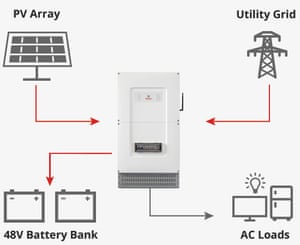Extract from The Guardian
Brisbane company Redback Technologies, backed by
researchers from the University of Queensland, says it has cracked
the formula for the most cost-effective solar storage system on the
Australian market
Low-cost solar
solutions for residential and commercial users has been seen as the
holy grail of the new energy frontier. Photograph: Seth Perlman/AP
Tuesday 23 February 2016 12.34 AEDT
If Tesla’s Powerwall is the “Lamborghini” of
the solar storage industry, a small Brisbane company backed by
University of Queensland
researchers says it has hit on the formula to deliver the “Toyota”.
Redback Technologies, which last week inked a
commercialisation deal with UQ, claims to have harnessed the power of
algorithmic software and efficient design to produce the most
cost-effective solar storage system on the Australian market.
Despite relying on a smaller battery than the
Powerwall – which is widely expected to be the catalyst for rapid
growth of the solar storage market this year – Redback says its
“Ouija board” system, available from June, will pay for itself in
half the time.
Redback’s founder and managing director, Philip
Livingston, said it would take an average 5.6 years to earn back the
Ouija’s $9,000 price tag through electricity bill savings, versus
11 years on the Powerwall’s $15,000 to $17,000 installation cost.
Philip Livingston, founder and managing director
of Redback Technologies.
Livingston said the company, set up just last
year, was less concerned with batteries as the cutting edge of the
household solar energy market as it was with tackling its key
problem: how can households consume more of the power their solar
panels produce?
“We’ve realised that even if batteries were
free today, they only count for about 25-30% of an overall system
cost, which means you don’t get anywhere near a five-year return on
investment,” he said.
Five years was considered the benchmark in 2012,
when returns for solar panel owners selling back to power companies
were at their high-water mark before state governments drastically
cut those rates.
“Fundamentally, the big thing we all need to be
talking about as consumers is not batteries or whatever, but
self-consumption – that is the itch we have to scratch,”
Livingston said.
The
big thing we all need to be talking about as consumers is not
batteries but self-consumption
Philip Livingston
The average solar-powered house consumed only
25-30% of the power it produced, the rest now fetching scant rates on
the wholesale power market, he said.
The Powerwall, with its Lithium battery, would
take “self-consumption” to 57%.
The Ouija system would better that at 61%, while
costing a third of the Powerwall, Livingston said.
This was in part because of a different approach
to design, he said. Redback’s system components were not separated
out and were lighter, he said, meaning they could be installed more
quickly and by fewer staff.
“The heaviest unit in the device is the
inverter, it’s 40kg; the battery enclosure we bring out next month
is 25kg and each battery you place inside it is 20kg and they’re
all outdoor-rated,” Livingston said.
“So effectively, a few guys and a small truck
can get it installed rather than four guys and a crane, which is what
you need for a Powerwall.
“In integrating these systems, what needs to be
considered is not just the aesthetic, but that all the other elements
add cost when integrating a system.
“While it’s great to have a battery that’s
really sexy, at the end of the day, a lot more people buy Toyotas
than they do Lamborghinis – or Teslas for that matter.”
Redback also claims to more efficiently exploit
its smaller battery by using a cloud-based software platform to
control appliances such as “hot water systems, heaters, pool pumps
and the like”.
“It’s not being done by a person per se –
although they can put schedules in – but by machine learning and
that’s where we’re going with this,” Livingston said. “People
don’t have to be focused on using expensive hardware solutions for
things that can be done with software.”

Redback Technologies’ Ouija solar storage
system.
This reliance on software to boost the efficient
use of power is what led Redback to signing its memorandum of
understanding with University of Queensland last week. “Who better
than a university that specialises in the creation of heuristic
algorithms for machine learning?” Livingston said.
“By working with UQ we are getting years and
years of experience of analytic calculations, supercomputers they
have on site, and we are able to use their faculties and build
machine-learning capabilities that allow us to optimise these types
of scenarios so we can become even less reliant on batteries over
time.”
Learning to drive energy efficiency through
software is a “rabbit hole that continues to grow because we are
learning how to optimise these scenarios to a greater and greater
extent”, Livingston said.
While the hardware is designed in Seattle and
manufactured in China, all the intellectual property is generated in
Brisbane,
where the company has 16 staff and plans to increase its ranks of
engineers.
Livingston, whose early career included installing
solar water systems in the Philippines with the US Peace Corps, said
he believed the Australian market for solar storage systems would
soon “cut across the ‘chasm’, as they call it, of early
adopters into the early majority” in line with the one in five
households that now had solar panels.
“It should be quick because the economics are
going to get even better than they are now,” he said.
Dean Moss, the chief executive of UniQuest, the
University of Queensland commercialisation arm whose past projects
include the cervical cancer preventing vaccine Gardasil, said the
collaboration with Redback would “convert research discoveries into
exciting, innovative new products that create change”.
Paul Meredith, the director of UQ Solar, said the
company with its “energy storage innovations [and] entrepreneurial
drive” would be tapping into an institution with “a rich history
of cutting-edge renewable energy research, particularly in the
systems integration space”.


No comments:
Post a Comment